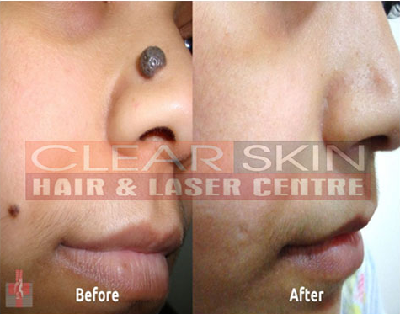Moles are the most common pigmented skin growths for every individual, in medical term the mole is called by ‘nevi’, and the moles have many types that can be appears as small raised dark brown spot, though the skin color can range from pink to black in any part of body of an individual. Moles can exist by birth only or in some it appears later. Usually, the moles mainly appear during the childhood and adolescence. Utmost grown up adults have 10 to 40 moles.
Moles are occur when melanocytes in the skin grow in a cluster rather than being spread throughout the skin and the main reason for excess of moles in children is sun exposure which causes an increase in the number of moles in the children’s body. Most grownup or adults has up to 10 to 40 moles.
Utmost moles are not much harmless, but in rare situations they become cancerous. However, in case of monitoring of the being moles and unforeseen multiple new eruptions is an important role for detecting skin cancer, called malignant melanoma.
Inheritable predisposition and abnormal exposure to the sun play an important part in increasing of moles. Hormonal changes during puberty and in pregnancy time of women can provoke melanocyte to develop the moles. Generally utmost moles do not require any treatment except for those cosmetically uninvited, but for those thicker moles it must require a Mole removal treatment.
Congenital moles are present at birth and are caused by melanocyte cells in the dermis-epidermis. These moles vary in size from small, medium, or giant. The giant congenital mole can turn cancerous as they ages to adult life.
Acquired moles are those that you develop later in life. Most of these are brown to dark brown and are found in people regularly exposed to the sun. These are dome-shaped smooth, pigmented with a distinct shape, and 3-6 mm in diameter. These moles are less likely or not likely to turn into cancer.
Acquired moles or nevi are further differentiated depending on the location of involvement
Here the melanocytes accumulate or proliferate between the epidermis and dermis to form these moles. They are raised, uniformly pigmented with a diameter of 2-6mm, and have regular borders.
Here the melanocyte proliferates in the epidermis and migrates into the dermis with the maturation of the cells in the deep dermis. They are round or oval with slightly raised in the central part and have flattened distinct borders.
They are located in the dermis and proliferate in deeper skin; hence they are not as pigmented as junctional or compound nevi. They are formed as we age and are flesh-colored, dome-shaped papule or nodule.
They are also called a dysplastic nevus. Atypical moles are often odd or irregular shapes, larger than a pencil end or eraser, and appear blurry with mixed color (brown, red, and pink). They are either raised or flat and look like melanoma. However, it is not melanoma but has a higher risk of forming melanoma or cancer. They can appear anywhere on the body, often seen on the trunk.
Surgical Excision is done to remove the congenital nevi or larger nevi which require closure of the wound.
Surgical shave with a sterile blade to remove superficial nevi like junctional nevi.
Radiosurgery by Ellman (internal link) is the best and reasonable price treatment to remove the mole and is done by reputed skin professionals.
Co2 & Er.YAG Lasers is performed to remove the compound or intradermal nevi, Q Switch Nd-YAG Laser can be performed to remove tiny and superficial moles like junctional nevi, as most of the time moles do not require skin biopsy and or removal.
Hence regular examination of moles and sun-exposed skin on a monthly or quarter yearly basis, as of risk factors and avoid suntan parlour
| DO | DON'T |
|---|---|
| Avoid direct sunlight for 2-4 weeks after the procedure. Sunscreen is a must. | Do not pick at your skin, as it can cause further skin damage and should be avoided. Allow the natural process of exfoliation to take its course. |
| Apply a cold pack or ice cube to the area to reduce swelling | Use any personal skin care products for 2 weeks after the procedure that cause burning or discomfort. |
| Wash your hands before touching your skin. | Do not let the skin feel dry or tight. Always keep it moisturized |
| Gentle skin moisturizer (oil free) can be used after 5 days of treatment. | Do not smoke for at least 2 weeks post-procedure as smoking significantly delays healing and increases the risk of complications |
| Avoid makeup for a 5 to 8days. | Don’t hesitate to call for any questions regarding your condition, it is best to call the during regular office hours. |
| Take over-the-counter pain medication when needed | Don’t forget to continue medication prescribed by doctor |

